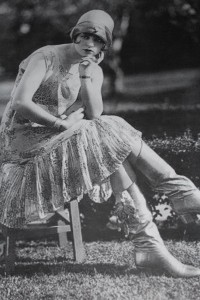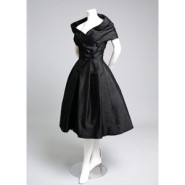AARP Hearing Center
ISO the ‘Perfect Dress’
By Barbara Hannah Grufferman, February 26, 2015 01:09 PM
Dress trends have come and gone over the years.

The Roaring Twenties were epitomized by the rise of Coco Chanel and the flapper look — short hair and short, shapeless shift dresses.
During the late 1930s and early ’40s, the glamour of Hollywood prevailed — until, of course, World War II broke out, making couture seem inconsequential. More structured dresses — inspired by military uniforms and fitting the mood of the times — then began to be worn with pride.
By the time the ’50s rolled around, American women were overdue for a little frivolity. They found it in the cinched-waist, full-skirted, figure-flattering dresses introduced by Christian Dior. Chanel, meanwhile, countered with the straight skirt and boxy jacket favored most famously by Jacqueline Kennedy.
Since then, every passing year — indeed, every turn of the season — has seen the introduction of the latest “perfect dress.” Often simply a recycled look from earlier years, all strive to be the right dress for every woman: flattering yet accessible, no matter how big or small your purse or waist.
>> Get travel discounts with your AARP Member Advantages.
But what truly distinguishes a dress as “perfect”?

“It’s one that accentuates your assets, flatters your body shape and makes you feel really pretty,” says Jacqui Stafford, author of The Wow Factor: Insider Style Secrets for Every Body and Every Budget. “And forget about the dress size listed on the tag — that number means nothing. All that matters is wearing what fits your body shape. A fabulous dress gives you the confidence to get out there and rule the world!”
Might there be a “magic dress” — one that flatters every woman’s frame, regardless of size, shape or age?
Believe it or not, there is — and not just one but three. Before describing them, let me also mention three guidelines for wearing them:
1. Keep the dress knee-length or slightly above.
2. Minimize frills.
3. Aim for fabrics that include a bit of Lycra for extra comfort and “give.”
- Wrap dress. Diane von Furstenberg hit the nail on the head in 1976 when she introduced the world to what many believe is the ultimate perfect dress: the wrap. Many designers have copied her styles since then, but the DVF original remains the archetype of a chic and knowing style. Look for long- or 3/4-length sleeves. Knot the belt on the side, not in front — and never tie it in a bow.
- Fit-and-flare. These über-flattering dresses — they’re simply modified and modernized versions of those postwar Dior dresses — are fitted on top and flare out slightly starting at the waist, creating a flirty, swingy look. For the best look, choose 3/4-length sleeves. Or if you want to go with a sleeveless number, pair it with a short, snugly fitting cardigan or a cool jean or leather jacket, like my fave at right. Be forewarned, though: If the cardigan or jacket is too long, it will flare out along with the skirt, adding a good — I mean bad! — 10 pounds to your frame.

- Sleeveless sheath dress. This universally flattering silhouette is perfect for almost any occasion. Pair it with a top as described above, or do your push-ups and go bare-armed! The key to wearing these successfully? Make sure they stretch a bit to fit your shape to a T.
For any dress to be truly “perfect,” of course, it must also be practical. For me, that means something I can wear for at least three seasons, and preferably four. Recently I managed to pull together one of my favorite dresses — a simple gray Helmut Lang shift dress — with various accessories that enabled me to wear it all year long. Perfection — or darn near it!
Until next time, remember: We can’t control getting older, but we can decide how we do it.
Photos: Grace Meihaus, Polyvore, AARP
A lso of Interest
- A Spring Beauty Trend to Try: The No-Makeup Look
- These 12 Fiction and Nonfiction Works Made Our Literary Year
- AARP Foundation Tax-Aide: Get Free Help Preparing and Filing Your Taxes
- Join AARP: Savings, resources and news for your well-being
See the AARP home page for deals, savings tips, trivia and more.































































